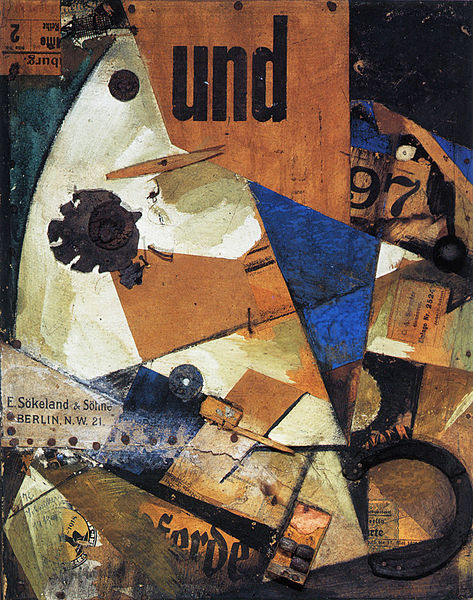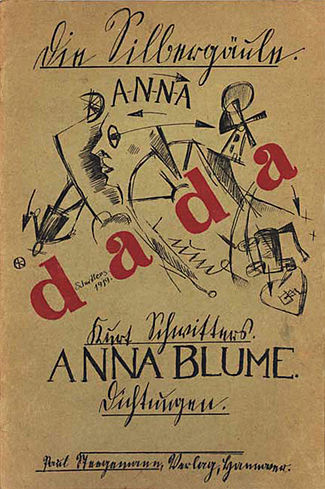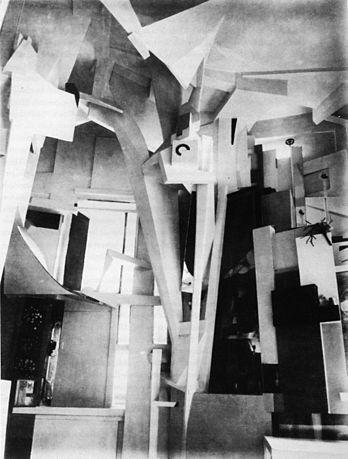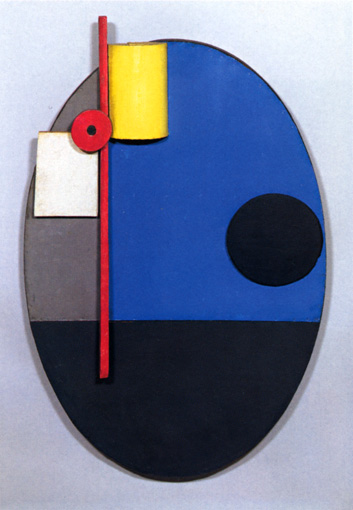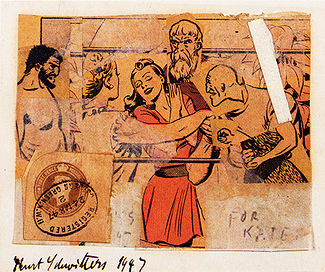<Back to Index>
- Painter Kurt Hermann Eduard Karl Julius Schwitters, 1887
PAGE SPONSOR
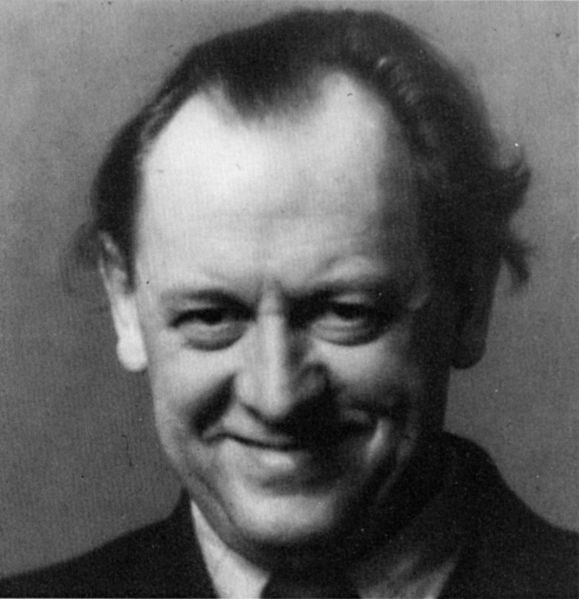
Kurt Hermann Eduard Karl Julius Schwitters (20 June 1887 – 8 January 1948) was a German painter who was born in Hanover, Germany.
Schwitters worked in several genres and media, including Dada, Constructivism, Surrealism, poetry, sound, painting, sculpture, graphic design, typography and what came to be known as installation art. He is most famous for his collages, called Merz Pictures.
Kurt Schwitters was born on 20 June 1887, at No.2 Rumannstraße, Hanover, the only child of Edward Schwitters and his wife Henriette (née Beckemeyer). His parents were proprietors of a ladies' clothes shop. They sold the business in 1898, using the money to buy five properties in Hanover which they rented out, allowing the family to live off the income for the rest of Schwitter's life in Germany. In 1901 the family moved to Waldstraße (later Waldhausenstraße) 5, future site of the Merzbau. The same year, Schwitters suffered his first epileptic seizure, a condition that would exempt him from military service in World War I until the last stages of the conflict, when conscription began to be applied to a far wider section of the population.
After studying art at the Dresden Academy alongside Otto Dix and George Grosz, (although Schwitters seems to have been unaware of their work, or indeed of contemporary Dresden artists Die Brücke), 1909 – 14, Schwitters returned to Hanover and started his artistic career as a post - impressionist. As the First World War progressed, however, his work became darker, gradually developing a distinctive expressionist tone. Expressionism was a predominantly German artistic movement best exemplified by Die Brücke, and by the paintings of Emil Nolde and Ernst Kirchner in particular.
Schwitters spent most of the war working as a technical draftsman in a factory just outside Hanover. He was drafted into the 73rd Hanoverian Regiment in March 1917, but exempted as unfit in June of the same year. By his own account, his time as a draftsman influenced his later work, using Machines as metaphors of human activity.
"In the war [at the machine factory at Wülfen] I discovered my love for the wheel and recognized that machines are abstractions of the human spirit."
He married his cousin Helma Fischer on 5 October 1915. Their first son, Gerd, died within a week of birth, 9 September 1916; their second, Ernst, was born on 16 November 1918, and was to remain close to his father for the rest of his life, up to and including a shared exile in London together.
In 1918, his art was to change dramatically as a direct consequence of Germany's economic, political and military collapse at the end of the First World War.
"In the war, things were in terrible turmoil. What I had learned at the academy was of no use to me and the useful new ideas were still unready.... Everything had broken down and new things had to be made out of the fragments; and this is Merz. It was like a revolution within me, not as it was, but as it should have been."
Schwitters was to come into contact with Herwarth Walden after exhibiting expressionist paintings at the Hanover Secession in February 1918. He showed two Abstraktionen (semi - abstract expressionist landscapes) at Walden's gallery Der Sturm, Berlin, June 1918, which led directly to meetings with members of the Berlin avant garde, including Raoul Hausmann, Hannah Höch and Hans Arp in the autumn of 1918.
"[I remember] the night he introduced himself in the Café des Westens. "I'm a painter," he said, "and I nail my pictures together." Raoul Hausmann
Whilst
Schwitters still created work in an expressionist style into 1919 (and
would continue to paint realist pictures up to his death in 1948), the
first abstract collages, influenced in particular by recent works by
Hans Arp, would appear in late 1918, which Schwitters dubbed Merz after a fragment of found text from the sentence Commerz Und Privatbank in his picture Das Merzbild, Winter 1918 – 19. By
the end of 1919 he had become famous, after his first one man exhibition
at Der Sturm gallery, June 1919, and the publication that August of the
poem An Anna Blume (usually translated as 'To Anna Flower', or 'To Eve Blossom'), a dadaist non - sensical love poem.
Schwitters asked to join Berlin Dada either in late 1918 or early 1919. According to Raoul Hausmann, Richard Huelsenbeck rejected the application because of Schwitters' links to Der Sturm and to Expressionism in general, which was seen by the Dadaists as hopelessly romantic and obsessed with aesthetics. Ridiculed by Huelsenbeck as ‘the Caspar David Friedrich of the Dadaist Revolution’, he would reply with an absurdist short story Franz Mullers Drahtfrühling, Ersters Kapitel: Ursachen und Beginn der grossen glorreichen Revolution in Revon published in Der Sturm (1922), which featured an innocent bystander who started a revolution 'merely by being there'.
Though not a direct participant in Berlin Dada's activities, he employed Dadaist ideas in his work, used the word itself on the cover of Anna Blume, and would later give Dada recitals throughout Europe on the subject with Theo Van Doesburg, Tristan Tzara, Hans Arp and Raoul Hausmann. In many ways his work was more in tune with Zürich Dada's championing of performance and abstract art than Berlin Dada's agit - prop approach, and indeed examples of his work were published in the last Zürich dada publication, der Zeltweg, November 1919, alongside the work of Arp and Sophie Tauber. Whilst his work was far less political than key figures in Berlin Dada, such as George Grosz and John Heartfield, he would remain close friends with various members, including Hannah Hoch and Raoul Hausmann for the rest of his career.
Merz has been called 'Psychological Collage'. Most of the works attempt to make coherent aesthetic sense of the world around Schwitters, using fragments of found objects. These fragments often make witty allusions to current events. (Merzpicture 29a, Picture with Turning Wheel, 1920 for instance, combines a series of wheels that only turn clockwise, alluding to the general drift Rightwards across Germany after the Spartacist Uprising in January that year, whilst Mai 191(9), alludes to the strikes organized by the Bavarian Workers' and Soldiers' Council.) Autobiographical elements also abound; test prints of graphic designs; bus tickets; ephemera given by friends. Later collages would feature proto - pop mass media images. (En Morn, 1947, for instance, has a print of a blonde young girl included, prefiguring the early work of Eduardo Paolozzi, whilst many works seem to have directly influenced Robert Rauschenberg, who said after seeing an exhibition of Schwitters' work at the Sidney Janis Gallery, 1959, that "I felt like he made it all just for me.")
He
was to use the term Merz for the rest of his career. Whilst these works
were usually collages incorporating found objects, such as bus tickets,
old wire and fragments of newsprint, Merz also included artist's periodicals, sculptures, sound poems and what would later be called "installations".
As the political climate in Germany became more liberal and stable, Schwitters' work became less influenced by Cubism and Expressionism. He started to organize and participate in lecture tours with other members of the international avant garde, such as Hans Arp, Raoul Hausmann and Tristan Tzara, touring Czechoslovakia, Holland, and Germany with provocative evening recitals and lectures.
Schwitters published a periodical, also called Merz, between 1923 – 32, in which each issue was devoted to a central theme. Merz 5, 1923, for instance, was a portfolio of prints by Hans Arp, Merz 8/9, 1924, was edited and typeset by El Lissitsky, Merz 14/15, 1925, was a typographical children's story entitled The Scarecrow by Schwitters, Kätte Steinitz and Theo Van Doesburg. The last edition, Merz 24, 1932, was a complete transcription of the final draft of the Ursonate, with typography by Jan Tschichold.
His work in this period became increasingly Modernist in spirit, with far less overtly political context and a cleaner style, in keeping with contemporary work by Hans Arp and Piet Mondrian. His friendship around this time with El Lissitzky proved particularly influential, and Merz pictures in this period show the direct influence of Constructivism.
Thanks to Schwitters' lifelong patron and friend Katherine Dreier,
his work was exhibited regularly in the US from 1920 onwards. In the
late 1920s he became a well known typographer; his best known work was
the catalogue for the Dammerstocksiedlung in Karlsruhe. After the demise of Der Sturm Gallery in 1924 he ran an advertising agency called Merzwerbe, which held the accounts for Pelikan inks and Bahlsen biscuits, amongst others, and became the official typographer for Hannover town council between 1929 and 1934. Many
of these designs, as well as test prints and proof sheets, were to crop
up in contemporary Merz pictures. In a manner similar to the
typographic experimentation by Herbert Bayer at the Bauhaus, and Jan Tschichold's Die neue Typographie,
Schwitters experimented with the creation of a new more phonetic
alphabet in 1927. Some of his types were cast and used in his work. In the late 1920s Schwitters joined the Deutscher Werkbund (German Work Federation).
Alongside his collages, Schwitters also dramatically altered the interiors of a number of spaces throughout his life. The most famous was The Merzbau, the transformation of six (or possibly more) rooms of the family house in Hannover, Waldhausenstrasse 5. This took place very gradually; work started in about 1923, the first room was finished in 1933, and Schwitters subsequently extended the Merzbau to other areas of the house until he fled to Norway in early 1937. Most of the house was let to tenants, so that the final extent of the Merzbau was less than is normally assumed. On the evidence of Schwitters' correspondence, by 1937 it had spread to two rooms of his parents' apartment on the ground floor, the adjoining balcony, the space below the balcony, one or two rooms of the attic and possibly part of the cellar. In 1943 it was destroyed in a bombing raid.
Early photos show the Merzbau with a grotto - like surface and various columns and sculptures, possibly referring to similar pieces by Dadaists, including the Great Plasto - Dio - Dada - Drama by Johannes Baader, shown at the first International Dada Fair, Berlin, 1920. Work by Hannah Höch, Raoul Hausmann and Sophie Tauber, amongst others, were incorporated into the fabric of the installation. By 1933, it had been transformed into a sculptural environment, and three photos from this year show a series of angled surfaces aggressively protruding into a room painted largely in white, with a series of tableaux spread across the surfaces. In his essay 'Ich und meine Ziele' in Merz 21, Schwitters referred to the first column of his work as the Cathedral Of Erotic Misery. There is no evidence that he used this name after 1930, however. The first use of the word 'Merzbau' occurs in 1933.
Photos of the Merzbau were reproduced in the journal of the Paris based group abstraction - création in 1933 - 4, and were exhibited in MoMA in New York in late 1936.
The Sprengel Museum in Hanover has a reconstruction of the first room of the 'Merzbau.
Schwitters later created a similar environment in the garden of his house in Lysaker, near Oslo, known as the Haus am Bakken (the house on the slope). This was almost complete when Schwitters left Norway for England in 1940. It burnt down in 1951 and no photos survive. The last Merzbau, in Elterwater, Cumbria, England, remained incomplete on Schwitters' death in January 1948. A further environment that also served as living space can still be seen on the island of Hjertoya near Molde, Norway. It is sometimes described as a fourth Merzbau, although Schwitters himself only ever referred to three.
Schwitters composed and performed an early example of sound poetry, Ursonate (1922 – 32; a translation of the title is Original Sonata or Primeval Sonata). The poem was influenced by Raoul Hausmann's poem "fmsbw" which Schwitters' heard recited by Hausmann in Prague, 1921. Schwitters
performed the piece regularly, developing and extending it, until
finally publishing his notations for the recital in the last Merz
periodical, 1932.
The political situation in Germany under the Nazis continued to deteriorate throughout the 1930s; he lost his contract with Hanover City Council in 1934 and examples of his work in German museums were confiscated and publicly ridiculed in 1935. By the time his close friends Christof and Luise Spengemann and their son Walter were arrested by the Gestapo in August 1936 the situation had clearly become perilous.
On 2 January 1937 Schwitters, wanted for an 'interview' with the Gestapo, fled Hanover to join his son Ernst in Norway, who had already left Germany on 26 December 1936. His wife Helma decided to remain in Hanover, to manage their four properties. In the same year, his Merz pictures were included in the Nazi exhibition titled "entartete Kunst" in Munich, making his return impossible. Helma visited for a few months each year up to the outbreak of World War II. The joint celebrations for his mother Henriette's 80th birthday and his son Ernst's engagement, held in Oslo on 2 June 1939, would be the last time the two met.
Schwitters started a second Merzbau while in exile in Lysaker nearby Oslo, Norway, in 1937 but abandoned it in 1940 when the Nazis invaded; this Merzbau was subsequently destroyed in a fire in 1951. His hut on the Norwegian island of Hjertøya, near Molde, is also frequently regarded as a Merzbau. This building has been more or less left to rot since 1940.
After a short period of internment on the Lofoten Islands, Schwitters fled to Scotland with his son on the icebreaker Fridtjof Nansen between 8 and 18 June 1940. By now an enemy alien, he was moved between various internment camps in Scotland and England before ending up spending a year and a half in Douglas Camp, Isle of Man. Whilst there, he staged regular Merz recitals, including a performance of Silence, his first poem in English, but was apparently seen as a somewhat pathetic irrelevant figure by other artists at the camp.
"I am now the last artist here - all the others are free. But all things are equal. If I stay here, then I have plenty to occupy myself. If I am released, then I will enjoy freedom. If I manage to leave for the U.S., then I will be over there. You carry your own joy with you wherever you go." Letter to Helma Schwitters, April 1941.
After intervention from Alexander Dorner, Rhode Island School of Design, Schwitters was finally released on 21 November 1941. He spent time in London, then in 1945 moved to the Lake District, where, in August 1947, he began work on the last Merzbau, which he called the Merzbarn. Made possible by a grant from MOMA that had originally been intended to help restore the Hannover original, one wall of this last structure is now in the Hatton Gallery in Newcastle; the shell of the barn remains in Elterwater, near Ambleside.
His
wife Helma died of cancer on 29 October 1944, although Schwitters only
heard of her death in December; at about the same time, he discovered that the Merzbau had
been destroyed during an allied air raid. After his son returned to
Norway, he left London with his new companion, Edith Thomas, (known as
'Wantee' for her habit of always asking guests if they'd like a cup of
tea) for the Lake District on 27 June 1945.
Cut off from the centers of the European Avant Garde, and with International Modernism beleaguered by rising tides of nationalism across Europe, Schwitters' work in exile became increasingly organic, with natural forms and muted colors replacing the mass produced ephemera of previous years. Pictures such as Small Merzpicture With Many Parts 1945 - 6 used objects found on a beach, including pebbles and smooth shards of porcelain.
After the war, his friend Käte Steinitz started to send letters back to Schwitters from the United States, where she had emigrated in 1936. She described life in the emerging consumer society, and wrapped the letters in pages of comics to give a flavor of the new world. She encouraged Schwitters to 'Merz' this ephemera, the result of which was a sequence of proto - pop art pictures such as For Käte, 1947.
Plagued
by health problems in his remaining years, including temporary
blindness in 1946 and a number of strokes, Schwitters died in Kendal, England, 8 January 1948, of a heart attack, and was buried in Ambleside. His grave was unmarked until 1966 when a stone was erected with the inscription Kurt Schwitters – Creator of Merz. The stone remains as a memorial even though his body was later disinterred and reburied in Hanover, Germany, the grave being marked with a marble copy of his 1929 sculpture Die Herbstzeitlose.
Many artists have cited Schwitters as a major influence, including Ed Ruscha, Robert Rauschenberg, Damien Hirst, Al Hansen, and Arman.
"The language of Merz now finds common acceptance and today there is scarcely an artist working with materials other than paint who does not refer to Schwitters in some way. In his bold and wide - ranging experiments he can be seen as the grandfather of Pop Art, Happenings, Concept Art, Fluxus, multimedia art and post - modernism." Gwendolyn Webster
Schwitters' son, Ernst, largely entrusted the artistic estate of his father to Gilbert Lloyd, director of the Marlborough Gallery. However, Ernst fell victim to a crippling stroke in 1995, moving control of the estate as a whole to Kurt's grandson, Bengt Schwitters. Controversy erupted when Bengt, who has said he has "no interest in art and his grandfather's works", terminated the standing agreement between the family and the Marlborough Gallery. The Marlborough Gallery filed suit against the Schwitters estate in 1996, after confirming Ernst Schwitters' desire to have Mr. Lloyd continue to administer the estate in his will.
Professor Henrick Hanstein, an auctioneer and art expert, provided key testimony in the case, stating that Schwitters was virtually forgotten after his death in exile in England in 1948, and that the Marlborough Gallery had been vital in ensuring the artist's place in art history. The verdict, which was eventually upheld by Norway's highest court, awarded the gallery USD 2.6 million in damages.
Schwitters' visual work has now been completely catalogued in the Catalogue Raisonné.
Forgeries of collages by Schwitters turn up almost weekly on eBay.
Before purchasing any work supposedly by Schwitters, it is best to
consult the Kurt Schwitters Archive at the Sprengel Museum in Hannover,
Germany.
